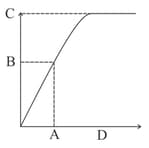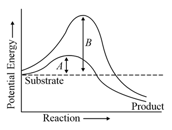MEDIUM
Earn 100
The junction between two adjacent cells of smooth muscle is called as:
(a)Desmosomes
(b)Gap junction
(c)Occluding junction
(d)Intermediate junction
100% studentsanswered this correctly
Important Questions on Develop and use a model to illustrate the hierarchical organization of interacting systems that provide specific functions within multicellular organisms.
MEDIUM
Life Sciences>From Molecules to Organisms: Structures and Processes>Develop and use a model to illustrate the hierarchical organization of interacting systems that provide specific functions within multicellular organisms.>Structure and Function - Multicellular organisms have a hierarchical structural organization, in which any one system is made up of numerous parts and is itself a component of the next level
MEDIUM
Life Sciences>From Molecules to Organisms: Structures and Processes>Develop and use a model to illustrate the hierarchical organization of interacting systems that provide specific functions within multicellular organisms.>Structure and Function - Multicellular organisms have a hierarchical structural organization, in which any one system is made up of numerous parts and is itself a component of the next level
HARD
Life Sciences>From Molecules to Organisms: Structures and Processes>Develop and use a model to illustrate the hierarchical organization of interacting systems that provide specific functions within multicellular organisms.>Structure and Function - Multicellular organisms have a hierarchical structural organization, in which any one system is made up of numerous parts and is itself a component of the next level


MEDIUM
Life Sciences>From Molecules to Organisms: Structures and Processes>Develop and use a model to illustrate the hierarchical organization of interacting systems that provide specific functions within multicellular organisms.>Structure and Function - Multicellular organisms have a hierarchical structural organization, in which any one system is made up of numerous parts and is itself a component of the next level
HARD
Life Sciences>From Molecules to Organisms: Structures and Processes>Develop and use a model to illustrate the hierarchical organization of interacting systems that provide specific functions within multicellular organisms.>Structure and Function - Multicellular organisms have a hierarchical structural organization, in which any one system is made up of numerous parts and is itself a component of the next level
EASY
Life Sciences>From Molecules to Organisms: Structures and Processes>Develop and use a model to illustrate the hierarchical organization of interacting systems that provide specific functions within multicellular organisms.>Structure and Function - Multicellular organisms have a hierarchical structural organization, in which any one system is made up of numerous parts and is itself a component of the next level
EASY
Life Sciences>From Molecules to Organisms: Structures and Processes>Develop and use a model to illustrate the hierarchical organization of interacting systems that provide specific functions within multicellular organisms.>Structure and Function - Multicellular organisms have a hierarchical structural organization, in which any one system is made up of numerous parts and is itself a component of the next level
MEDIUM
Life Sciences>From Molecules to Organisms: Structures and Processes>Develop and use a model to illustrate the hierarchical organization of interacting systems that provide specific functions within multicellular organisms.>Structure and Function - Multicellular organisms have a hierarchical structural organization, in which any one system is made up of numerous parts and is itself a component of the next level
The graph below depicts the velocity of an enzyme-catalyzed reaction vs. substrate concentration. Identify the alphabets with the correct descriptions.

I. Enzyme activity
II. Substrate concentration at maximum velocity
III. Substrate concentration at which half of the maximum velocity
IV. Half of the maximum velocity
HARD
Life Sciences>From Molecules to Organisms: Structures and Processes>Develop and use a model to illustrate the hierarchical organization of interacting systems that provide specific functions within multicellular organisms.>Structure and Function - Multicellular organisms have a hierarchical structural organization, in which any one system is made up of numerous parts and is itself a component of the next level
EASY
Life Sciences>From Molecules to Organisms: Structures and Processes>Develop and use a model to illustrate the hierarchical organization of interacting systems that provide specific functions within multicellular organisms.>Structure and Function - Multicellular organisms have a hierarchical structural organization, in which any one system is made up of numerous parts and is itself a component of the next level
MEDIUM
Life Sciences>From Molecules to Organisms: Structures and Processes>Develop and use a model to illustrate the hierarchical organization of interacting systems that provide specific functions within multicellular organisms.>Structure and Function - Multicellular organisms have a hierarchical structural organization, in which any one system is made up of numerous parts and is itself a component of the next level
EASY
Life Sciences>From Molecules to Organisms: Structures and Processes>Develop and use a model to illustrate the hierarchical organization of interacting systems that provide specific functions within multicellular organisms.>Structure and Function - Multicellular organisms have a hierarchical structural organization, in which any one system is made up of numerous parts and is itself a component of the next level
EASY
Life Sciences>From Molecules to Organisms: Structures and Processes>Develop and use a model to illustrate the hierarchical organization of interacting systems that provide specific functions within multicellular organisms.>Structure and Function - Multicellular organisms have a hierarchical structural organization, in which any one system is made up of numerous parts and is itself a component of the next level
EASY
Life Sciences>From Molecules to Organisms: Structures and Processes>Develop and use a model to illustrate the hierarchical organization of interacting systems that provide specific functions within multicellular organisms.>Structure and Function - Multicellular organisms have a hierarchical structural organization, in which any one system is made up of numerous parts and is itself a component of the next level
EASY
Life Sciences>From Molecules to Organisms: Structures and Processes>Develop and use a model to illustrate the hierarchical organization of interacting systems that provide specific functions within multicellular organisms.>Structure and Function - Multicellular organisms have a hierarchical structural organization, in which any one system is made up of numerous parts and is itself a component of the next level
Statement I : Tendons attach one bone with another bone.
Statement II : Epiglottis is formed by elastic cartilage.
The correct option among the following is
EASY
Life Sciences>From Molecules to Organisms: Structures and Processes>Develop and use a model to illustrate the hierarchical organization of interacting systems that provide specific functions within multicellular organisms.>Structure and Function - Multicellular organisms have a hierarchical structural organization, in which any one system is made up of numerous parts and is itself a component of the next level
Reason : It is formed by fusion of cells
EASY
Life Sciences>From Molecules to Organisms: Structures and Processes>Develop and use a model to illustrate the hierarchical organization of interacting systems that provide specific functions within multicellular organisms.>Structure and Function - Multicellular organisms have a hierarchical structural organization, in which any one system is made up of numerous parts and is itself a component of the next level
MEDIUM
Life Sciences>From Molecules to Organisms: Structures and Processes>Develop and use a model to illustrate the hierarchical organization of interacting systems that provide specific functions within multicellular organisms.>Structure and Function - Multicellular organisms have a hierarchical structural organization, in which any one system is made up of numerous parts and is itself a component of the next level

EASY
Life Sciences>From Molecules to Organisms: Structures and Processes>Develop and use a model to illustrate the hierarchical organization of interacting systems that provide specific functions within multicellular organisms.>Structure and Function - Multicellular organisms have a hierarchical structural organization, in which any one system is made up of numerous parts and is itself a component of the next level
EASY
Life Sciences>From Molecules to Organisms: Structures and Processes>Develop and use a model to illustrate the hierarchical organization of interacting systems that provide specific functions within multicellular organisms.>Structure and Function - Multicellular organisms have a hierarchical structural organization, in which any one system is made up of numerous parts and is itself a component of the next level

